Galaxy S9 and S9+ Review: Android Greatness for Less
While AR Emoji and other tricks don't impress, the Galaxy S9+'s improved camera, brighter display and faster performance add up to make this a worthy iPhone X rival.
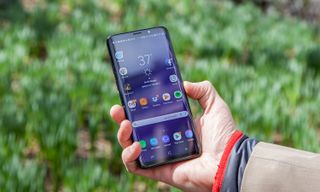
The Galaxy S10 and Galaxy S10 Plus are two of the best Android phones around, but the Galaxy S9 (now $599) and Galaxy S9+ ($699) deliver a lot of phone for less money. You get solid cameras with a fun Super Slow-Mo video mode and swift performance inside handsets that are among the sleekest in their price range.
No, you won't get the ultra-wide camera in the Galaxy S10 lineup or a fingerprint reader in the screen. But, overall, the Galaxy S9 and Galaxy S9+ are pretty great values, and today some of the best used smartphones around. We've also picked out the best Galaxy S9 cases.
Galaxy S9 and Galaxy S9+ Specs and Price
| Row 0 - Cell 0 | Galaxy S9 | Galaxy S9+ |
| Price | From $599 | From $699 |
| Display | 5.8 inches (2960 x 1440 pixels) | 6.2 inches (2960 x 1440 pixels) |
| Camera | 12-MP Super Speed Dual Pixel (f/1.5 - f/2.4) | 12-MP Super Speed Dual Pixel (f/1.5 - f/2.4), 12-MP telephoto with 2x zoom (f/2.4) |
| Front Camera | 8-MP (f/1.7) | 8-MP (f/1.7) |
| CPU | Snapdragon 845 | Snapdragon 845 |
| RAM | 4GB | 6GB |
| Storage | 64GB, 128GB, 256GB | 64GB, 128GB, 256GB |
| microSD | Up to 400GB | Up to 400GB |
| Battery | 3,000 mAh | 3,500 mAh |
| Colors | Midnight Black, Coral Blue, Lilac Purple, Sunrise Gold | Midnight Black, Coral Blue, Lilac Purple, Sunrise Gold |
| Size | 5.8 x 2.7 x 0.33 inches | 6.2 x 2.9 x 0.33 inches |
| Weight | 5.8 ounces | 6.7 ounces |
Design: Now even awesomer
I'll give Samsung a pass for not changing the design of the Galaxy S9 much, because the phone's edge-to-edge Infinity Display already looked stunning when it was introduced a year ago on the Galaxy S8. This time around, Samsung trimmed the bezels slightly on the top and bottom, giving you the same size displays in slightly more compact packages.
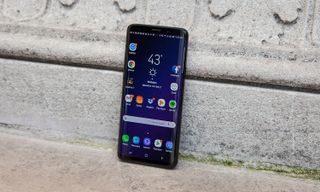
The S9+ measures 6.2 x 2.8 X 0.33 inches, while the S8+ is 6.3 x 2.9 x 0.3 inches. However, the newer S9+ is heavier than its predecessor, at 6.7 versus 6.1 ounces, likely owing to the addition of the second rear-camera lens. The S9 is a lighter 5.8 ounces.
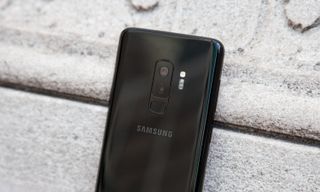
The biggest change is on the back of the S9 and S9+, as Samsung wisely moved the fingerprint sensor so that it sits beneath the camera instead of to the right of the lens (which is also a problem with the Note 8). And yet, despite this tweak, the reader is still pretty close to the bottom lens; it took a couple of days of practice for me to target the sensor correctly, but by that time, I had moved on to the iris and face-recognition methods for unlocking the phone.
Sign up to get the BEST of Tom's Guide direct to your inbox.
Here at Tom’s Guide our expert editors are committed to bringing you the best news, reviews and guides to help you stay informed and ahead of the curve!
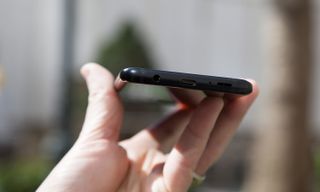
The S9+ and S9 are available in Midnight Black, Coral Blue and Lilac Purple. We received the black model, which is sleek enough for a business setting but kind of boring. We would much prefer a pop of color. As with the S8, Samsung's new phones are IP68 water resistant, so you can dunk them in up to 5 feet of water for 30 minutes without fear. The new phones also include headphone jacks, but the backs pick up smudges easily.
Alas, the Bixby button remains on the left side, right underneath the volume button, which resulted in several accidental presses on my part. The good news is that you can turn this function off, but you can't remap the button to launch another app.
Durability: Tough to a point
We tested the toughness of the Galaxy S9 by dropping it on its face onto wood from a height of 4 feet and 6 feet; we then dropped it on its edge and face onto concrete from 4 feet. We also dropped it on its edge and face from 6 feet onto concrete.
Drops from 4 feet and 6 feet onto wood caused no damage whatsoever to the S9. A 4-foot face drop onto concrete caused the S9's screen to crack, but the phone was still largely usable. Following that, a 6-foot drop onto its edge caused more damage, as did a face drop from that height.
Finally, a 4-foot drop into a water-filled toilet didn't cause much more damage to occur, but by this point, the screen was shattered pretty thoroughly. It survived, though, which earned it a toughness score of 6 out of 10. To see the results of other smartphones, as well as our complete scoring methodology, check out our smartphone drop tests.
Display: It’s killer
A funny thing happened with the iPhone X. Even though that phone reportedly packs a Samsung-made OLED screen, it beat Samsung's own phones in our screen shootout last fall, achieving the highest brightness (indoors), widest viewing angles and most-natural-looking colors.
Samsung has responded with the Galaxy S9+, whose curved display offers a brighter picture than the S8+ and covers even more of the color gamut than the iPhone X and Pixel 2 XL.
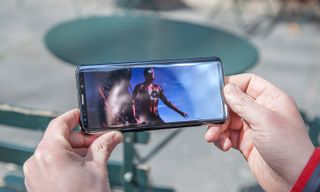
On our light meter, the S9's display registered a whopping 603 nits, which is higher than the Pixel 2 XL's 438 nits and even higher than the iPhone X's 574 nits. The S9+ got even brighter at 630 nits. However, it's important to note that Samsung's panels don't get this bright manually; you'll have to be in direct sunlight. Under normal indoor conditions, the max brightness on the iPhone X is higher than the S9 or S9+.
The S9 definitely has the most colorful panel around, though, as it reproduces a whopping 220 percent of the SRGB color gamut. The S9+ registered 231 percent. That's much higher than the results from the iPhone X (128.6 percent) and Pixel 2 XL (120 percent).
In side-by-side viewing of a scene from the Black Panther on the Galaxy S9+, iPhone X and Pixel 2 XL, the S9+ delivered the best image quality. The greens and blues popped more on the S9+’s panel, even though the iPhone X’s display shined brighter. The Pixel 2 XL’s image looked a little flat by comparison.
My only nitpick with this curved panel is that it can sometimes be difficult to press buttons on the extreme edges of the display; on more than one occasion I had to press twice for something to register.
Audio: A big boost
I did something I've never done before when reviewing the Galaxy S9. I left the phone on for hours by my side playing music as I wrote this review and did my testing. That's because the sound coming from the stereo speakers at the top and bottom of the S9 is just that good.
When I streamed Alice Merton's "No Roots," the vocals sounded clear even at maximum volume and the drums had a nice punch to them. With the S9 and S9+ delivering 1.4 times more volume than the S8 and S8+, I also had an easier time hearing directions coming from Google Maps while I drove.
MORE: Galaxy S9+ Battery Life: Here's How It Stacks Up
Although there's not a lot of content that supports it yet, both the S9 and S9+ support Dolby Atmos technology. This fools your ear into believing that sound is coming at you from different directions in 3D space, making movies more immersive.
Camera: Low-light improvement, Super Slow-mo fun
Boasting a new variable aperture, the Galaxy S9's new Super Speed Dual Pixel camera is designed to let in 28 percent more light than the S8. The aperture automatically adjusts from f/1.5 to f/2.4, depending on the conditions. In addition, the camera offers dedicated memory for reducing noise.
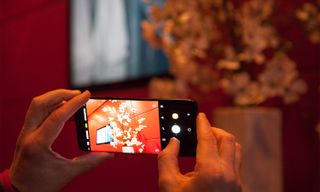
The results were fairly impressive in my testing, although the S9 and S9+ still trail the Pixel 2 and iPhone X in overall image quality. If you like the idea of 2x optical zoom or you want to take convincing-looking portraits, the S9+ is the phone to get, as its dual rear lenses give you those benefits. The regular S9 has a single rear shooter.
The Galaxy S9+ did a good job capturing a piñata indoors with some light streaming in through the window (to the left). When you zoom in, there's definitely less noise and more detail in the Samsung's shot. However, the oranges, purples and yellows are more vibrant in the iPhone X's photo.
In much dimmer conditions, the S9+ pulled off a cool-looking shot at the Campbell bar in New York City. The glass in the background is well-defined, and you can make out the bartender, although the bottoms of some of the glass bottles get blown out.

The Galaxy S9 offered the best focus in this shot of a raspberry tart dessert, and the powdered sugar looks delicious. However, the red looks more luscious and the gold foil more lustrous on the iPhone X.
In this challenging photo taken inside Grand Central Terminal, the Pixel 2's image offered the clearest shot of the clock and the most-legible image of the signs. The Galaxy S9's shot offers truer colors, though.
For video, the Galaxy S9 and S9+ up the ante with Super Slow-Mo, which lets you capture footage at 960 frames per second at 720p resolution. By comparison, the iPhone X and Pixel 2 XL record at just 240 fps (1080p) and 120 fps (1080p), respectively.
To test out Super Slow-Mo, I shot this quick video of someone playing ping pong. The footage looked great, and his backspin shot looked dramatic. From there, I swiped up on the clip to apply my choice of one of three nifty effects: Loop, Reverse or Swing. I picked Loop and then shared the video out to Facebook as a GIF.
My only complaint with Super Slow-Mo is that I wasn't always able to pick the exact right moment to film. In auto mode, the S9 is smart enough to detect motion and activate slow motion, but you might want to switch to manual so you can pick the exact moment you want to slow things down. I found it tricky to capture my son dribbling a basketball between his legs.
AR Emoji: More creepy than cool
If you've been jealous of Apple's Animoji on the iPhone X, the AR Emoji feature on the Galaxy S9 and S9+ is probably not going to help. Using the S9's front camera, you can create a 3D avatar of yourself (similar to Bitmoji) and then create a gallery of GIFs and stickers you can share of yourself via all sorts of apps. The idea is fun, but the execution is lacking.
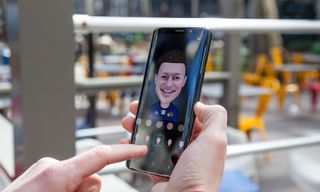
The AR Emoji I created just had a passing resemblance to myself, and then one my daughter created looked almost nothing like her, except that it somehow managed to pick up some acne in her forehead — not cool. Her take: "Tell Samsung they need to do a better job, because this is the worst ever."
To be fair, another AR Emoji I created of my father-in-law looked almost spot on, right down to his mustache and glasses. But that was the exception. I just wish there were more clothes options for personalizing your emoji.
You can also record videos using your AR Emoji, but I would advise against it unless you want to freak people out. The resulting footage looked jittery, and the S9+'s front camera didn't do an accurate job mirroring my facial movements. The TrueDepth camera on the iPhone X does a much better job with this sort of thing, although you're limited to using just animals.
MORE: AR Emoji vs. Animoji: It's Not Even Close
Security: Intelligent Scan is handy, but it's no Face ID
The Galaxy S9 has an answer for Apple's Face ID, but it's not a great one. A new Intelligent Scan feature combines facial recognition with iris scanning to unlock your device. The good news is that you don't even need to touch the display (unlike with the iPhone X) to get into your phone. You just stare at it. The bad news is that Intelligent Scan doesn't work as well as Face ID, and not just because you can't verify purchases with it.
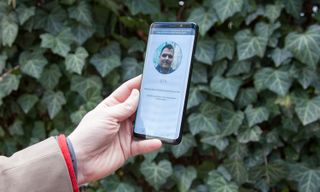
For starters, Samsung warns you via its disclaimer that "your phone could be unlocked by someone or something that looks like you." That means that, just as with the Galaxy S8, someone could get into your S9 or S9+ using a photo of you. By contrast, the 3D sensor inside the iPhone X creates a depth map of your face using 30,000 invisible dots, so it’s more secure.
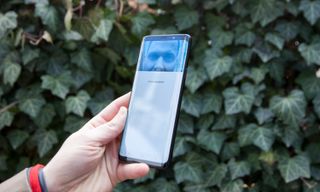
My other nitpick with Intelligent Scan is that the S9+ kept prodding me to hold the phone more upright; I don't have to do that with the iPhone X to get into the device. Lastly, the IR sensor pulsates as it reads your eyes, which was disconcerting to me. (The disclaimer also warns against using this feature with infants, as it may damage their eyesight.)
If you're worried about security, I would advise using the fingerprint sensor to unlock your phone, even though Intelligent Scan is slightly more convenient.
Performance: A step up
Powered by Qualcomm's Snapdragon 845 processor and 6GB of RAM, the Galaxy S9+ is an absolute beast. The Galaxy S9 is swift, too, but it's a little less powerful because it has 4GB of RAM.
When playing Tekken on the expansive 6.2-inch display with 18 other apps open in the background, I executed three combos in a row — including an explosive kick to the face — and the S9+ never stuttered.
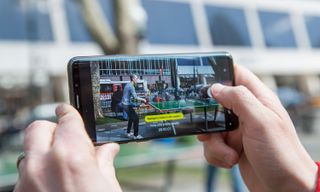
In terms of sheer processing might, the A11 Bionic chip in the latest iPhones is the fastest around, but Samsung is closing the gap. In our video-editing test, which involves exporting a 2-minute 4K video file, the Galaxy S9+ took 2 minutes and 32 seconds. The Galaxy S9 took 3:29. Both of those times are behind the iPhone X's 42 seconds. The Pixel 2 XL took 2:55 with its older Snapdragon 835 chip.
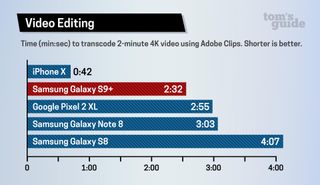
The Galaxy S9+ also opened demanding apps more slowly than the iPhone X did. For instance, it took the iPhone X a little more than 13 seconds to fire up the Injustice 2 game, compared to 20 seconds for the S9+. And the iPhone X was about 5 seconds faster when opening Tekken 2.
The Galaxy S9 and S9+ were no match for Apple's A11 Bionic on Geekbench 4, which measures overall performance. The S9 hit 7,276 and the S9+ 8,295, compared to 10,357 for the iPhone X.
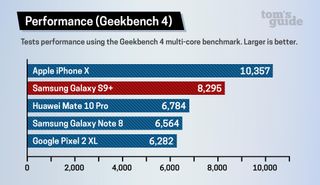
On 3DMark's Sling Shot benchmark, which measures graphics performance, the Galaxy S9 scored 5,739, which beats the iPhone X (3,998). However, on the more demanding Sling Shot Extreme OpenGL ES 3.1 benchmark, the iPhone X notched 4,994 to the Galaxy S9+'s 4,634. The regular S9 hit 4,617.
When it comes to 4G LTE performance, the Galaxy S9+ smoked the iPhone X in side-by-side tests over T-Mobile's network. On the Speedtest.net app, the S9+ averaged 71.6 Mbps downloads and 10.1 Mbps uploads. The iPhone X mustered 48.8 Mbps down and 7.7 Mbps up.
The based model of the Galaxy S9+ comes with 64GB of storage, and you can add a microSD card with up to 400GB. No iPhone lets you do that. A month after the S9's debut, Samsung started offering 128GB and 256GB versions of both the S9 and S9+ for an extra $50 and $100, respectively.
Software: Bixby Vision and AR take center stage
Running Android 8.0 Oreo, the Galaxy S9+ is anything but a stock Android phone. The Edge panel — a series of shortcuts you can access by swiping in from the right side of the screen — is very much all Samsung. The most compelling feature is App Pair, which lets you launch two apps side by side (or top and bottom) with a single touch. For example, I found pairing up email and Facebook to be a good work-and-play combo.

Bixby, Samsung's digital assistant, is the hallmark feature on this flagship, and the assistant has developed some new talents since Samsung introduced it on the S8. For instance, using Bixby Vision and the Galaxy S9's camera, you can point the phone at food and get a calorie count, as I did with a green apple. You can also translate foreign languages on the fly, whether it's a menu, a sign or anything with text. I successfully translated some French headlines to English using this feature on the Le Monde site.
There are some rough edges to Bixby Vision. For example, the Shopping tool accurately identified a jar of Jif peanut butter I held in front of the phone, but when I switched over to the Food tool, the Galaxy S9+ couldn't tell what the object was.
I also had some trouble using the Place finder feature, which is supposed to overlay information on the camera view to show you things like business names, depending on where you point the phone. Unfortunately, the S9 showed me a listing for the Sweetgreen salad place as I pointed the camera directly at a Hale and Hearty Soups.
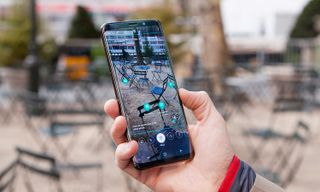
Although I didn't test Bixby's virtual makeup tool, my colleague Caitlin was generally impressed by it. Using the S9's front camera, you can try on everything from lipstick and eyeshadow to blush; if you like what you see, you can buy it on the spot from Sephora.
Otherwise, Bixby is more of a time-saver than an all-knowing assistant, reducing the number of steps it takes to perform complex actions. For instance, I loved that I could say, "Add this video to my family album," after pressing the Bixby button instead of performing the task myself with a series of taps.
Battery Life: Excellent
The Galaxy S9+ can easily last a full workday on a charge, but the S9's endurance could be better. On the Tom's Guide Battery Test, which involves continuous web surfing over 4G LTE, the S9+ handset lasted a superb 10 hours and 59 minutes, which is comparable to the Galaxy S8+'s 11:04 and a little bit longer than the iPhone X's 10:49.
On the same test, the regular S9 endured for an average of 10:52 over LTE. That's better than the iPhone X but is behind the Pixel 2 XL (12:09).
All of these phones were tested on T-Mobile's network.
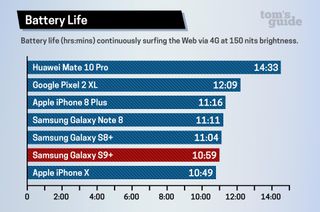
Galaxy S9/S9+ vs. iPhone X and Pixel 2 XL
Priced starting at $840 (depending on the carrier), the Galaxy S9+ has a significant price advantage over the iPhone X ($999). For $160 less, Samsung gives you a much bigger display (6.2 versus 5.8 inches), which you'll likely appreciate when typing, reading documents and watching videos. The S9+ also benefits from removable storage and a headphone jack, not to mention the ability to run two apps side by side.
The regular Galaxy S9 (from $720) is cheaper than the S9+, but you'll have to do live with a smaller 5.8-inch screen, a smaller battery and less RAM (4GB vs 6GB for the S9+). Plus, the S9+ packs dual rear cameras to the S9's single lens.
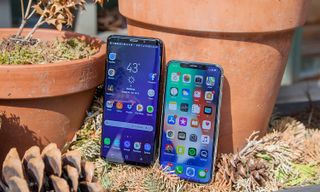
However, the iPhone X boasts a brighter display with more-accurate colors, a slightly better camera and more reliable Face ID biometric security. And that phone's A11 Bionic chip is more powerful. The iPhone 8 Plus ($799) has the same processor and great dual cameras as the iPhone X, but its 5.5-inch LCD display looks dated next to the OLED panel on the S9+.
MORE: Best small phones
The biggest advantage the Pixel 2 XL has over the Galaxy S9 and S9+ is the Google device's camera, as it edged out Samsung's handset in our camera shootout. Google's phone also offers even longer life and a pure version of Android. But the Galaxy S9+ has dual rear cameras, which make for better-looking portraits; a faster Snapdragon 845 processor; and a sleeker, edge-to-edge design.
Bottom Line
The Galaxy S9 and S9+ deliver nearly everything you could want in a flagship phone for less money, including speedy performance, good low-light photography, fantastic displays and impressive battery life (the S9+ wins there).
But the S9 and S9+ are also proof that smartphones are starting to hit a wall in terms of radical new changes that companies can make from one generation to the next. Between these phones' lackluster AR Emoji and not-quite-nailed Bixby features, Samsung seems to be lurching a bit in order to trumpet that these are "new" phones and not just great upgrades.
But there's absolutely nothing wrong with great upgrades. And all of the big and little enhancements for the S9 and S9+ make them worth the investment, especially if you don't want to overspend for your next phone.
Credit: Tom's Guide
Mark Spoonauer is the global editor in chief of Tom's Guide and has covered technology for over 20 years. In addition to overseeing the direction of Tom's Guide, Mark specializes in covering all things mobile, having reviewed dozens of smartphones and other gadgets. He has spoken at key industry events and appears regularly on TV to discuss the latest trends, including Cheddar, Fox Business and other outlets. Mark was previously editor in chief of Laptop Mag, and his work has appeared in Wired, Popular Science and Inc. Follow him on Twitter at @mspoonauer.
